Rupert Neve 511 and 517 Modules Review
Rupert Neve Design’s foray into API’s 500-series comes with two unique mic preamps. Mike Hillier finds space for the rack… Details Price 511 £520, 517 £649 Contact Sonic Distribution Web www.rupertneve.com Adapting existing designs for the 500-series is always a challenge. In addition to the limits of physical space inside a single module, the format […]
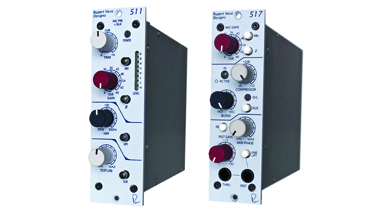
Rupert Neve Design’s foray into API’s 500-series comes with two unique mic preamps. Mike Hillier finds space for the rack…
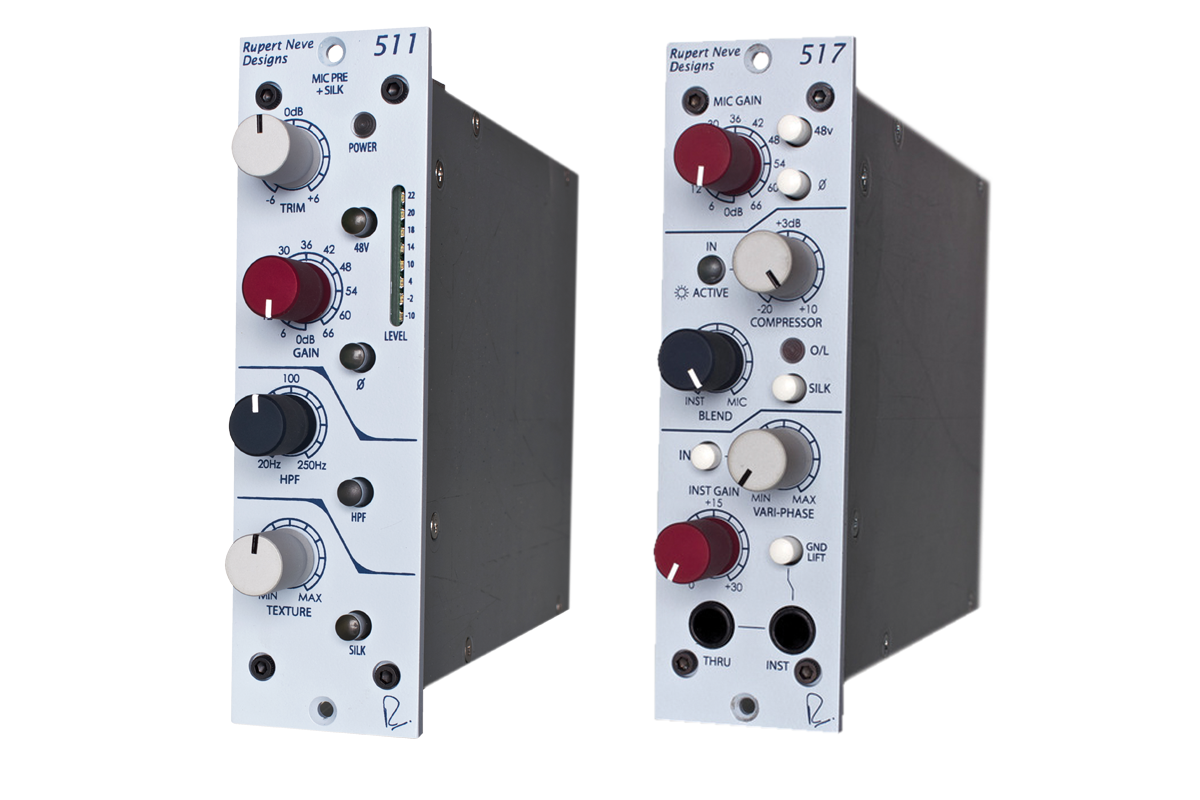

Details
Price 511 £520, 517 £649
Contact Sonic Distribution
Web www.rupertneve.com
Adapting existing designs for the 500-series is always a challenge. In addition to the limits of physical space inside a single module, the format has very strict current and voltage restraints. Rupert Neve “experimented with a number of different transformer and circuit designs to achieve the same presence and sweetness found in the Portico Series of modules”.
At their most basic, the 511 and 517 modules share the same preamp design. They both use a Transformer-Like-Amplifier non-reactive circuit, with a gain switch providing up to 66dB of gain in 6dB increments. Both have +48V phantom power for condenser microphones, and a polarity invert switch. However, beyond this simple preamp topology, the two modules differ, with each module suited to different tasks.
511
The 511 adds a +/-6dB trim control to the basic preamp, which means when it’s flat out the 511 is capable of 72dB of gain, while at its lowest setting the 511 will actually attenuate the input signal by 6dB. The preamp feeds a switchable 12dB/octave high-pass filter with a continuously variable cutoff frequency, from 20Hz to 250Hz.
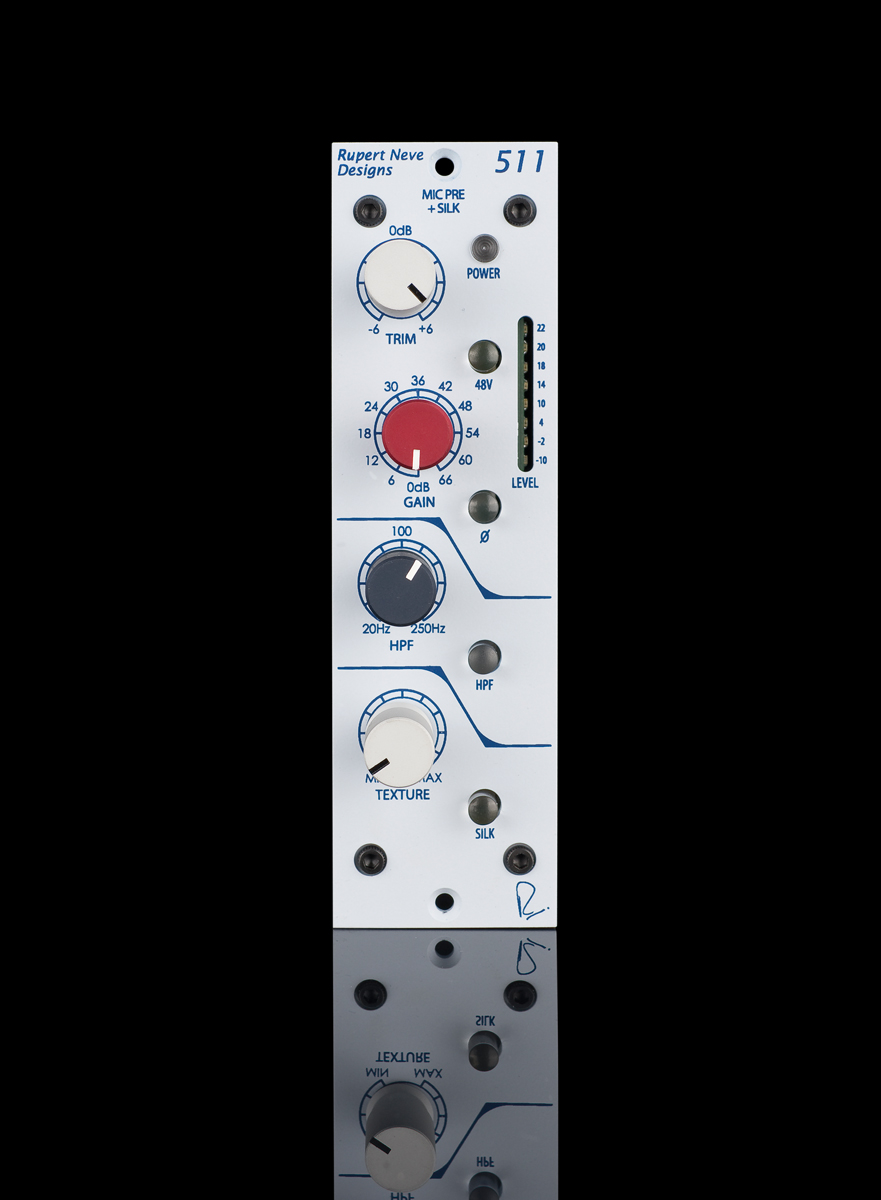
This in turn feeds Rupert Neve Designs’ Red Silk circuit, which can be switched in and out, and the amount of texture from the silk circuit can be dialled in, from so subtle it’s almost absent at the minimum position, to a setting with roughly 10 times the harmonic distortion as the original silk circuit in the Portico designs.
517
The RND 517 module lacks the trim and high-pass filter controls of the 511, simplifying the mic preamp section, but instead feeds the signal into an optical compressor with a fixed 2:1 ratio. The compressor has only a threshold control, leaving the attack and release characteristics to the opto-cell. No gain reduction monitoring is present, but you can see when the compressor is active with a single LED.
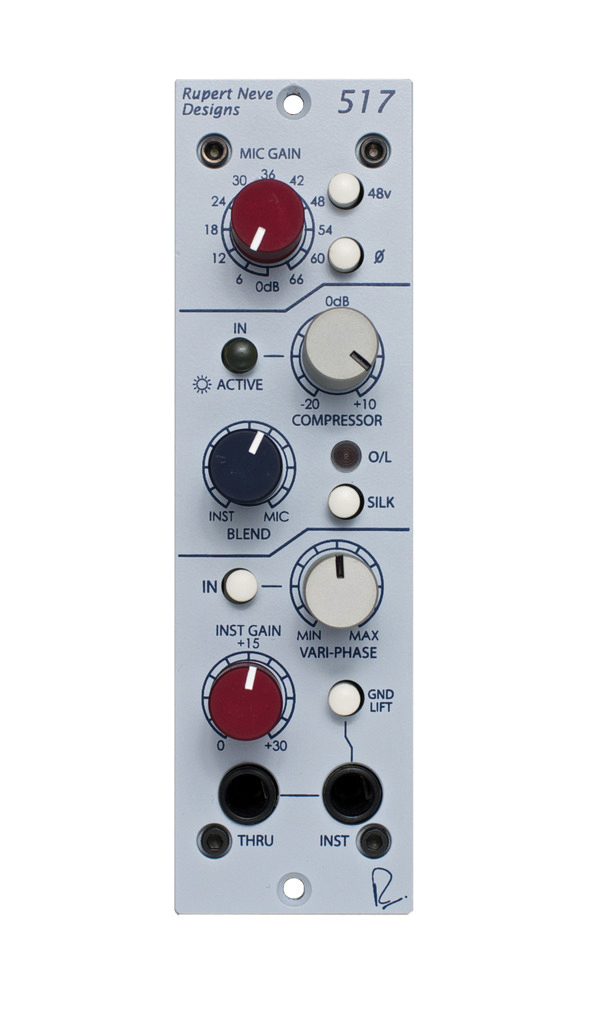
In addition to the mic preamp, the 517 has a DI input. However, unlike many preamps with built-in DIs, the DI is not simply a hi-impedance input to the mic preamp, it’s a separate input entirely, which can be blended with the mic signal. To access the DI you must use the 1/4in jack socket on the front panel. A 1/4in Thru socket is also included for sending the signal back out into an amplifier.
This enables you to record the DI’d signal at the same time as the mic’d instrument or amplifier, controlling the blend between the two inside the 517 using the Blend knob, and sending a single mono output to your DAW or recording medium. To keep the two signals in phase, the DI’d signal has a Variable Phase knob.
Finally, the output of the 517 has a switchable Silk setting, which can be used to reduce negative feedback and introduce small amounts of harmonic distortion to colour the output.
Alternatives
The 511 preamp is one of the better 500-series preamps we’ve tried, although it has some stiff competition in this range from the likes of SSL, AMS Neve and API. The 517 is more unique, providing DI and mic preamp in one.
This same sound could be achieved with a DI and mic preamp separately – although to get the vari-phase option you would have to then move the files in your DAW or add a phase tool such as the Little Labs IBP.
In the Studio
While the two preamps share the basic structure, the 511 is more refined for basic preamping duties. This is, in large part, down to the variable texture as opposed to the simple on/off switch on the 517, and the high-pass filter, which enabled us to filter out low-end rumble and proximity effect and leave only the signal we wanted.
We began recording an acoustic guitar. We’re not generally fond of DIs on acoustic guitars and opted to use the 511 mic preamp, this time with an Ear Trumpet Labs Edwina large diaphragm condenser microphone.
The Blueridge dreadnaught-style acoustic guitar we used has a wonderful tone, and the mic and preamp combination worked wonders at capturing the guitar, with just enough depth from the body of the guitar and great tonal definition from the strings, without too much string buzz or finger noise. On the 511 we dialled the high-pass filter up just enough to rule out any rumble from reaching the recording, but not enough to affect the signal. We experimented with the Texture control, deciding in the end to set it at around 11 o’clock, for just a touch of extra colour.
Next up we recorded a vocal, again using the 511 as our preamp. Our vocalist’s voice was a little thin, so we paired the 511 with a dynamic mic – the Heil PR40 – using the proximity effect to our advantage, and dialled the high-pass filter in just right, to prevent the proximity effect from sounding boomy, but still adding some weight to the vocal. To give the vocal a little more depth we engaged the Texture knob and dialled it all the way up. The extra saturation from the Texture even at this setting didn’t sound forced, or even lo-fi, it simply added some much needed character to the vocal.
On bass guitar we usually record a DI signal, and then reamp this in parallel, either through a real amp, or with an amp simulator, to add colour, and to provide extra definition in the upper harmonics. We used the 517 to DI the bass guitar then ran the signal back out using the Thru output on the 517 into a small Orange combo bass amp. The amplifier cabinet was then mic’ed with the Heil PR40 running back into the mic input of the 517.
To set the gain of the DI and mic portions of the signal we set the blend knob to 100% DI, set the DI gain, then to 100% mic and set the mic gain. We then set the blend to 50% and used the Variphase control to find the position with the thickest sounding bottom end. An interesting trick here is to flip the polarity of the mic signal, then dial in the variphase until the signal is at its quietest – i.e. most out of phase – then flip the polarity back to get the two signals at their most in-phase.
With the two signals properly gain staged and in phase, we finally dialled in a blend that was nearer to what we wanted for the track – around 60% amp signal, 40% DI in this instance.
The optical compressor on the 517 is perfectly tuned for bass guitar, and we dialled this in to only just tickle the signal, with the LED lighting up only on the more heavily plucked sections. A little more visual feedback for the compressor would be nice, if only to see how much we were shaving off, but this method does at least force you to use your ears.
Finally, we experimented with the silk switch. As the silk can’t be dialled in on the 517, we opted not to use it, preferring to get our colour from the amp and compressor, but could easily imagine opting to use that instead of the compressor on some bass parts.
While some engineers prefer to record both the DI and mic’ed signals separately, we enjoyed being forced to make decisions during recording. The bass recording sat in our mix perfectly with very little extra EQ.
Practical Tip
To go with the preamps, Rupert Neve Designs also sent along its R6 chassis. This chassis holds six 500-series modules – not only Rupert Neve’s own of course, but any of the hundreds now available.
It has XLR, TRS and D-Sub inputs and outputs. And, so you don’t lose the extra two-channels over an eight-channel D-Sub, two additional channels of XLR and TRS I/O are provided simply for ‘Thru’ connectivity.
Racking Up
Both the 511 and 517 are great preamps, easily worthy of finding themselves in the best studios in the world. Despite the extra functions in the 517 it’s the 511 that we consider to be the more flexible, and were we to equip a studio with just these preamps – not a terrible proposition – we’d prefer to have a bank of 511 preamps with one or two 517 preamps for handling bass and guitar.
The lack of a high-pass filter isn’t hugely important – we can always add one as a plug-in later in the mix – although it would be useful to have one to filter out sub-harmonic noise before it reaches the compressor
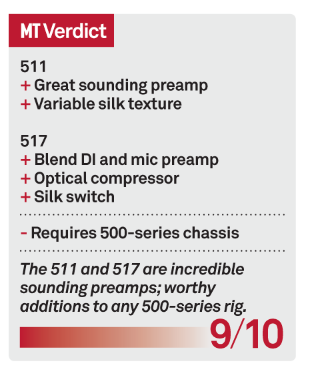
Key Features
511
● Mic pre with 72dB gain
● Variable high-pass filter
● Variable silk control
517
● Mic pre with 66dB gain
● One knob compression
● Fixed silk control
● DI with 30dB gain
● Variable phase
● Variable blend between Mic and DI


